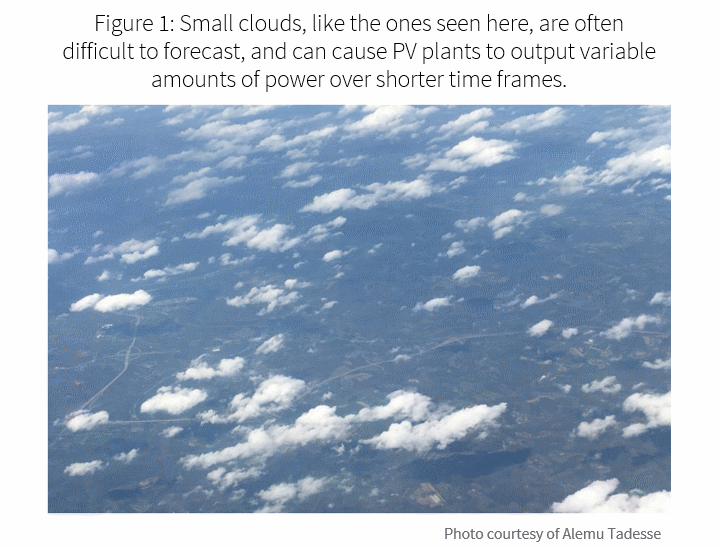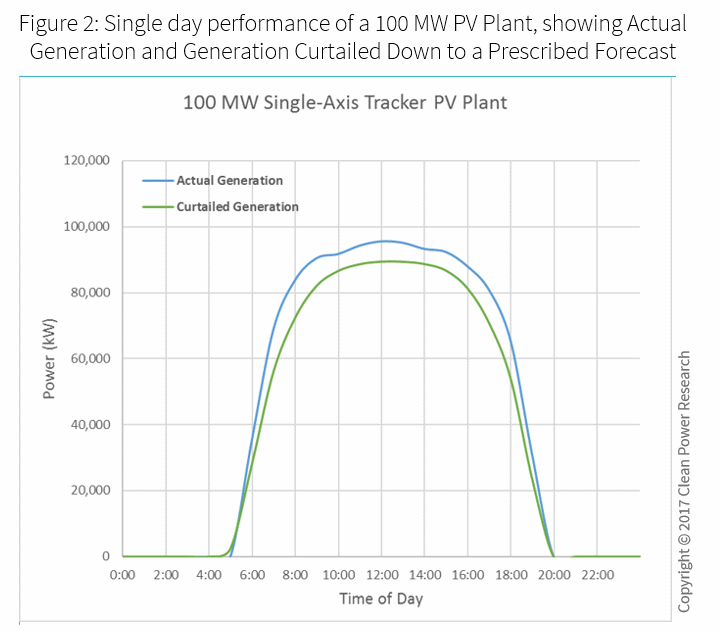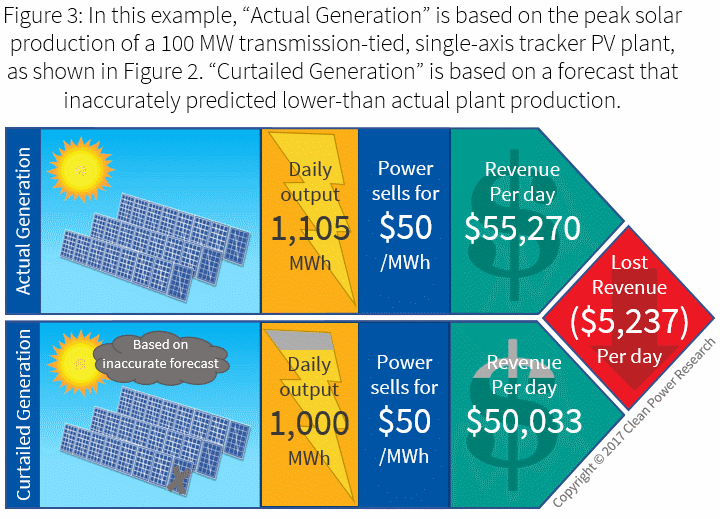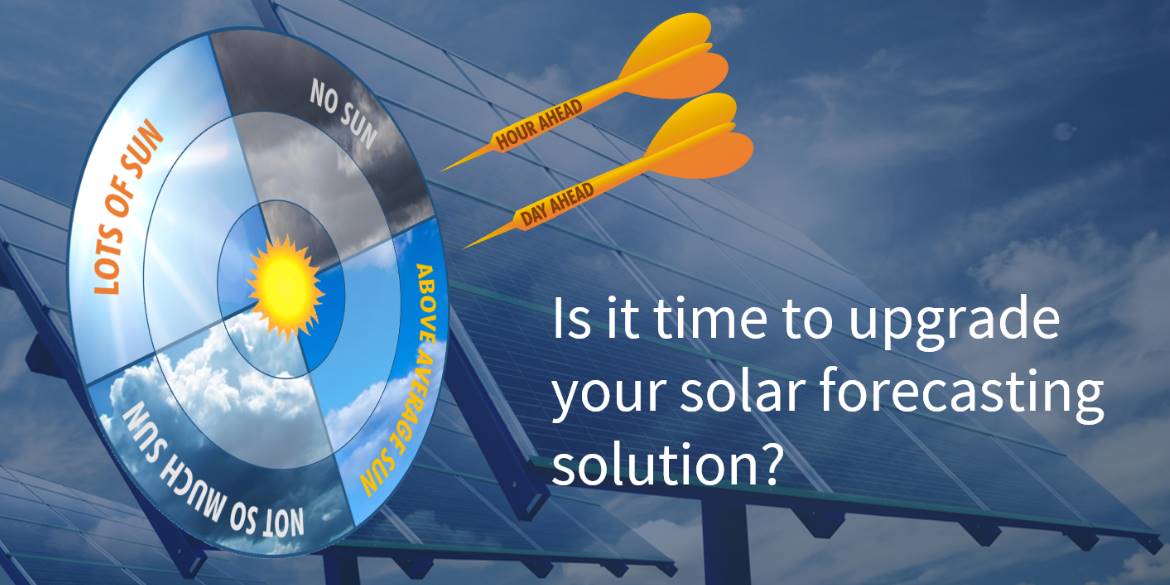The importance and source of solar forecasting
With an increasing number of installed utility-scale PV plants and a growing need for predictable energy generation, the solar industry has started paying attention to solar forecasting. The reasons behind this are:
- Solar generation is variable in nature.
- Being able to predict solar output will make the electric grid work better under variable conditions.
Essentially, solar forecasting provides a way for grid operators to predict and balance energy generation and consumption. Assuming the grid operator has a mix of generating assets at their disposal, reliable solar forecasting lets that operator best optimize the way they dispatch their controllable units. Capabilities will vary from grid to grid, but the application of a solar forecast largely remains the same.
A few key components make up solar forecasting tools. First, there is the weather model. As mentioned, solar generation is variable by nature. Cloud cover causes this variability by impeding sunlight from hitting the solar panels. If you can predict the weather with a great amount of certainty, you’re already one step ahead.
The second factor in a solar forecast is the model used to convert the weather into utility plant power output. The solar industry uses these “PV simulation” models to predict the performance of a PV plant under environmental conditions like irradiance, wind speed, temperature and relative humidity. PV simulation models also incorporate important plant behaviors such as tracking, which predicts the orientation of the PV panels mounted on single- or dual-axis tracking hardware.
Ultimately, accurate weather models and PV simulation tools are both needed to produce an accurate and useful solar energy forecast.

Where do solar forecasts go wrong?
“Essentially, all models are wrong, but some are useful”
-George E.P. Box (renowned statistician)
Errors in solar forecast accuracy arise either from the weather prediction or PV simulation step. Forecasting the weather is, well, like trying to forecast the weather. Though the solar industry has progressed in creating better weather forecasts, a lot of work is left to do in the way of fundamental model development, application and analysis.
For example, multiple weather forecast techniques can be used to predict cloud cover and irradiance. These could include:
- Numerical weather prediction (NWP) models, which use physical relationships to predict large-scale atmospheric trends and are good for longer (one day ahead and further) forecast horizons. NWP models have a limited capability to predict smaller clouds, such as the ones in Figure 1.
- Satellite cloud motion vector forecasts, which use satellite imagery to predict near-term cloud motion from geostationary satellites. Satellite forecasts are dominant in the short-term, typically up to 4-6-hours ahead, and are the best method to detect small clouds such as the ones in Figure 1.
Inaccuracies in NWP and satellite models largely arise from model biases and localized weather conditions. The use of statistical approaches to blend multiple forecast model inputs, or computer vision technologies such as artificial neural networks can help increase accuracy.
A perfect weather forecast, however, can still lead to a bad solar forecast. PV simulation tools are needed to appropriately translate weather conditions into solar plant performance. PV systems made of modules wired to inverters have a complex response to environmental conditions. Physical and empirical models work best at translating conditions into predicted output. Statistical approaches that link PV behavior to irradiance (or other weather variables) typically fail due to the non-linearity of that relationship.
For example, a statistical PV model is used as the example “Curtailed Generation” forecast in Figure 2. It under-predicts the energy output and misses the “shoulder” shape of the single-axis tracker. By using a more accurate physical tracking model that explicitly predicts the tracker movement, the actual generation curve can be achieved.

What happens when solar forecasts go wrong? Added cost.
Forecasts attempt to predict the future, which likely means they’re wrong more often than right. What happens when a solar forecast is wrong? The effects of incorrect solar forecasts really boil down to adding cost to the energy market.
From the grid operator perspective, an inaccurate solar forecast means that they need to make up for unpredicted imbalance with shorter-term sources of power. These short-term sources tend to be costlier on a per unit basis, which also means that the extent of total inaccuracy is important. For instance, the total cost to make up a 10% error on a 20 MW and 100 MW plant will be different. This cost can then be passed through from the grid operator to the market participants.
Grid operators have used mechanisms like imbalance/penalty charges and reliability curtailment to pass on the costs of grid imbalance to the market. In the former example, imbalance charges are assigned to deviations from forecasted production to allow the market to replace missing energy. These types of penalties have existed with controllable generation to assure reliable power delivery to the grid operator but are now becoming an option for renewable plant operators that see economic value in using forecasts to schedule power. Accurate forecasting is definitely required to take on that type of additional risk.
Alternatively, some grid operators have implemented reliability curtailment where the operator can step down solar production to the forecasted amount to force grid balance. This can still be costly to a plant owner if they rely on poor solar forecasts, as outlined in Figure 2 below.

What can you do?
If you’re a solar plant owner/operator and are concerned about lost revenue due to use of inaccurate solar forecasts, I encourage you to ask how your forecast is being created:
- What weather models are being used?
- What PV simulation model is being used?
After that, feel free to reach out to us at support@solaranywhere.com and we can help identify causes of solar forecast errors. Clean Power Research continues to improve SolarAnywhere through more accurate data versions and new product features that ensure our users are relying on the most accurate solar forecast tools.
